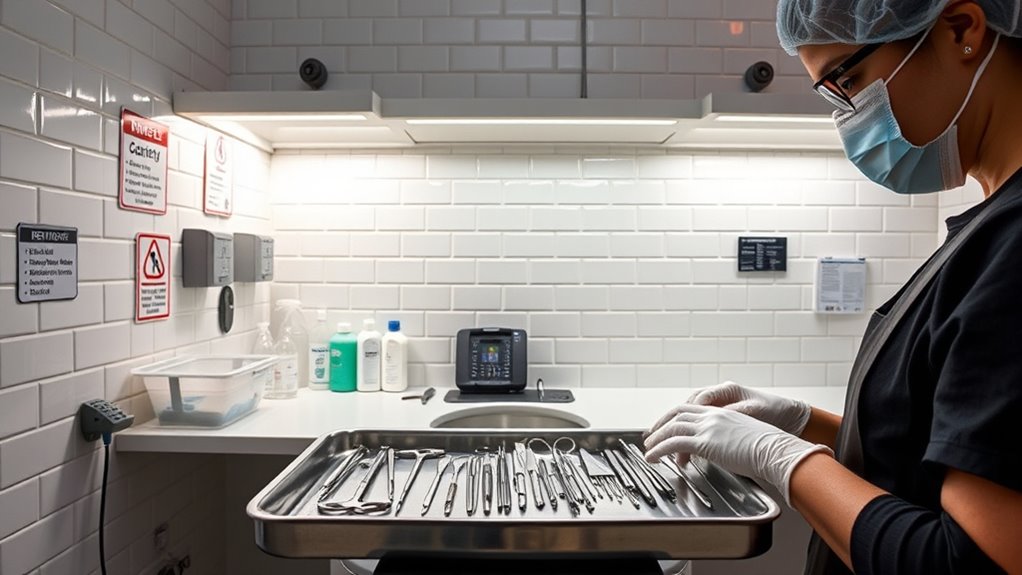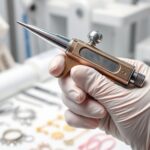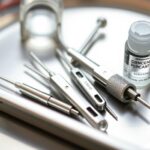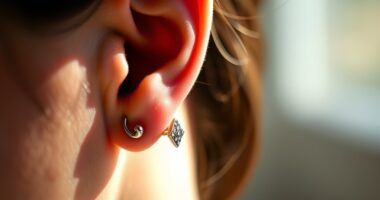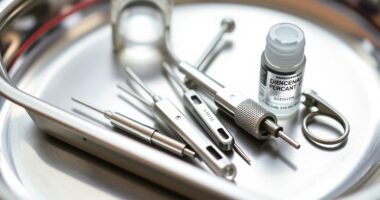To guarantee safety at piercing studios, you must follow strict regulations like proper sterilization of tools with autoclaves, use disposable items, and keep your workspace clean. Staff should be well-trained in hygiene practices, and surfaces must be disinfected regularly. Proper disposal of sharps and contaminated materials is essential. Transparency about safety procedures builds client trust. Staying compliant with health standards guarantees a safe environment—continue to explore for detailed safety tips that protect everyone involved.
Key Takeaways
- Proper sterilization of tools using autoclaves or approved methods is mandatory before each use.
- Staff must receive comprehensive training on hygiene, sterilization, and safety protocols.
- Studios must maintain a clean workspace, disinfect surfaces regularly, and dispose of sharps properly.
- Transparency about sterilization procedures and staff credentials builds client trust and confidence.
- Ongoing compliance with health regulations and routine inspections ensure safety standards are consistently met.
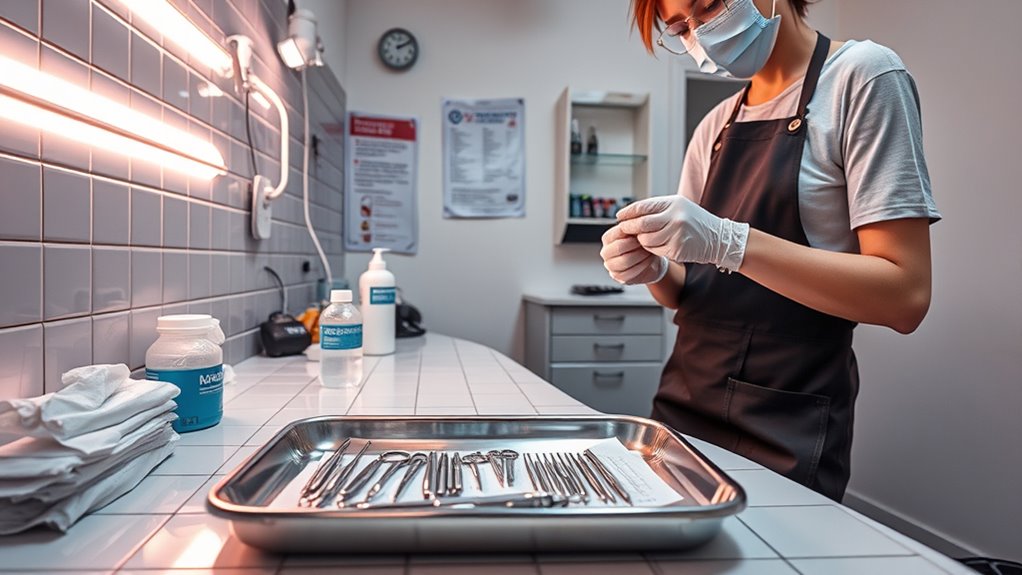
Ensuring safety in a piercing studio isn’t just a recommendation—it’s a necessity. When you step into a place where body modifications are performed, you need to trust that strict sterilization procedures are in place. These procedures are the backbone of infection control, and they must be rigorously followed to prevent the spread of bacteria, viruses, and other pathogens. You should see that all reusable tools are properly sterilized using autoclaves or other approved methods before each use, and single-use items are discarded immediately after the procedure. This attention to sterilization isn’t just about compliance; it’s about protecting your health and ensuring that your piercing heals as intended.
Proper sterilization safeguards your health and ensures safe, hygienic piercings.
Equally important is staff training. Every employee working in the studio should have extensive training on hygiene practices, sterilization techniques, and safety protocols. Proper staff training ensures that everyone understands the critical importance of maintaining a sterile environment and knows how to handle equipment correctly. Well-trained staff can identify potential issues before they compromise safety, such as improperly sterilized tools or contaminated surfaces. They should also be prepared to educate clients on aftercare, helping to minimize risks of infection or complications later on. When staff training is prioritized, it creates a culture of safety, where best practices become second nature.
You also need to verify that the studio complies with all relevant health regulations. This includes maintaining a clean workspace, using disposable gloves, and practicing good hand hygiene. It’s essential that the studio has clear protocols for cleaning and disinfecting surfaces regularly, especially in high-touch areas. Proper disposal of sharps and contaminated materials should be strictly enforced, with designated containers readily available. These practices, combined with diligent sterilization procedures and ongoing staff training, form a thorough safety net that protects both clients and staff. Additionally, regular inspections and adherence to HEALTH STANDARDS ensure that the studio maintains a high level of safety and professionalism.
Furthermore, transparency about safety standards can give you peace of mind. Reputable studios openly share their sterilization procedures and staff credentials. Don’t hesitate to ask questions about their safety practices or request to see their sterilization equipment in action. This proactive approach ensures you’re choosing a studio that prioritizes your safety above all else. When you understand and see the commitment to strict sterilization procedures and ongoing staff training, you can feel confident that your piercing experience will be safe, hygienic, and professional. Remember, safety isn’t just a policy—it’s a fundamental part of every quality piercing studio’s commitment to their clients.
Frequently Asked Questions
Are There Specific Licensing Requirements for Piercing Studios?
Yes, you need to meet specific licensing requirements for piercing studios. You must obtain industry licensing to operate legally and guarantee compliance with health standards. Additionally, your studio should have proper certification, demonstrating it meets safety and hygiene protocols. These requirements help protect your clients and establish credibility. Make sure to stay updated on local regulations, as licensing and certification processes can vary by location.
How Often Should Sterilization Equipment Be Inspected and Maintained?
An ounce of prevention is worth a pound of cure. You should inspect and maintain your sterilization equipment regularly, ideally according to your equipment maintenance schedule—usually weekly or monthly. Follow strict sterilization protocols to guarantee safety and avoid contamination. Regular inspections help catch issues early, maintaining a sterile environment and protecting your clients. Consistent maintenance isn’t just good practice; it’s essential for upholding safety standards and your studio’s reputation.
What Training Is Mandatory for Piercing Studio Staff?
You need to guarantee your staff has mandatory piercing certification, which covers essential health and safety protocols. This training includes proper sterilization techniques, cross-contamination prevention, and safe piercing practices. By obtaining and maintaining this certification, your team stays compliant with industry standards, reducing risks for clients. Regular updates on health and safety regulations are also vital, so your staff remains informed about the latest best practices in piercing studios.
Are There Age Restrictions for Clients in Piercing Studios?
You should be aware that most piercing studios set age restrictions to protect teen clients. Typically, teens under 18 need parental consent to get pierced. Some studios might have stricter policies or require a parent or guardian to be present during the procedure. Always check your local regulations and studio policies beforehand. Ensuring proper parental consent helps keep the process safe and compliant with legal standards for teen clients.
How Is Compliance With Safety Standards Monitored and Enforced?
You guarantee compliance with safety standards through regular inspection protocols and compliance auditing. Authorities or licensing bodies conduct routine inspections to verify that your studio follows hygiene, sterilization, and safety guidelines. They review your procedures, equipment, and record-keeping practices. If issues arise, you’ll be required to address them promptly. Staying proactive by maintaining thorough documentation and training helps you pass inspections and stay compliant with regulations.
Conclusion
By following these safety standards, you’re building a fortress of trust and cleanliness around your studio. Each sterilized tool, every sanitized surface, acts as a brick in your foundation of professionalism. When you prioritize safety, you craft a sanctuary where artistry and hygiene dance hand in hand. Keep these regulations close like a guiding star, and watch your reputation shine brighter than ever, illuminating your path to success with the glow of trust and care.

